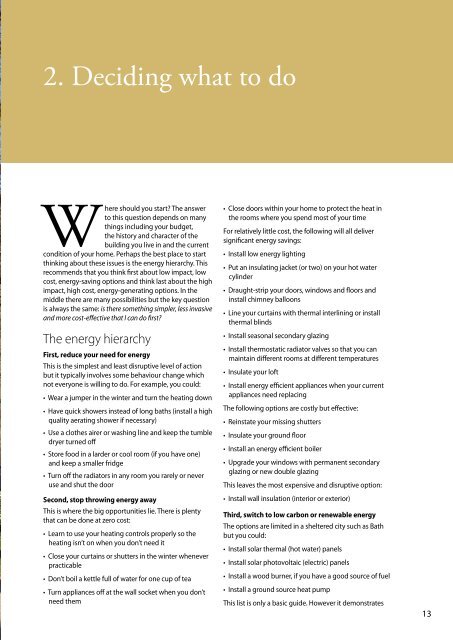Warmer Bath
Create successful ePaper yourself
Turn your PDF publications into a flip-book with our unique Google optimized e-Paper software.
Improving the energy efficiency of traditional homes in the City of <strong>Bath</strong><br />
2. Deciding what to do<br />
Where should you start? The answer<br />
to this question depends on many<br />
things including your budget,<br />
the history and character of the<br />
building you live in and the current<br />
condition of your home. Perhaps the best place to start<br />
thinking about these issues is the energy hierarchy. This<br />
recommends that you think first about low impact, low<br />
cost, energy-saving options and think last about the high<br />
impact, high cost, energy-generating options. In the<br />
middle there are many possibilities but the key question<br />
is always the same: is there something simpler, less invasive<br />
and more cost-effective that I can do first?<br />
The energy hierarchy<br />
First, reduce your need for energy<br />
This is the simplest and least disruptive level of action<br />
but it typically involves some behaviour change which<br />
not everyone is willing to do. For example, you could:<br />
• Wear a jumper in the winter and turn the heating down<br />
• Have quick showers instead of long baths (install a high<br />
quality aerating shower if necessary)<br />
• Use a clothes airer or washing line and keep the tumble<br />
dryer turned off<br />
• Store food in a larder or cool room (if you have one)<br />
and keep a smaller fridge<br />
• Turn off the radiators in any room you rarely or never<br />
use and shut the door<br />
Second, stop throwing energy away<br />
This is where the big opportunities lie. There is plenty<br />
that can be done at zero cost:<br />
• Learn to use your heating controls properly so the<br />
heating isn’t on when you don’t need it<br />
• Close your curtains or shutters in the winter whenever<br />
practicable<br />
• Don’t boil a kettle full of water for one cup of tea<br />
• Turn appliances off at the wall socket when you don’t<br />
need them<br />
• Close doors within your home to protect the heat in<br />
the rooms where you spend most of your time<br />
For relatively little cost, the following will all deliver<br />
significant energy savings:<br />
• Install low energy lighting<br />
• Put an insulating jacket (or two) on your hot water<br />
cylinder<br />
• Draught-strip your doors, windows and floors and<br />
install chimney balloons<br />
• Line your curtains with thermal interlining or install<br />
thermal blinds<br />
• Install seasonal secondary glazing<br />
• Install thermostatic radiator valves so that you can<br />
maintain different rooms at different temperatures<br />
• Insulate your loft<br />
• Install energy efficient appliances when your current<br />
appliances need replacing<br />
The following options are costly but effective:<br />
• Reinstate your missing shutters<br />
• Insulate your ground floor<br />
• Install an energy efficient boiler<br />
• Upgrade your windows with permanent secondary<br />
glazing or new double glazing<br />
This leaves the most expensive and disruptive option:<br />
• Install wall insulation (interior or exterior)<br />
Third, switch to low carbon or renewable energy<br />
The options are limited in a sheltered city such as <strong>Bath</strong><br />
but you could:<br />
• Install solar thermal (hot water) panels<br />
• Install solar photovoltaic (electric) panels<br />
• Install a wood burner, if you have a good source of fuel<br />
• Install a ground source heat pump<br />
This list is only a basic guide. However it demonstrates<br />
13


